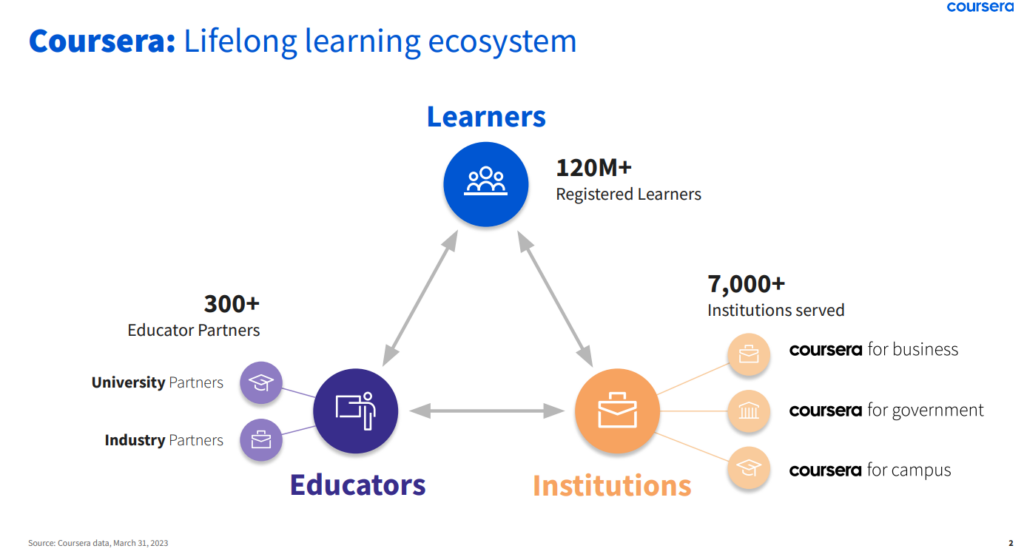
Tech Wire Asia had the chance to interview Raghav Gupta, the Managing Director of Coursera India & Asia Pacific, discussing the emergence of generative AI that has created an unprecedented demand for reskilling. Source: Shutterstock
Here’s how Coursera embraces the potential of generative AI
- Tech Wire Asia had the chance to interview Raghav Gupta, the Managing Director of Coursera India & Asia Pacific
- We discussed the ways in which the emergence of generative AI has created an unprecedented demand for reskilling.
- Raghav also spoke about the state of the job market and the impact of technology like generative AI on jobs that until now didn’t seem so vulnerable.
Being one of the world’s first and largest online learning platforms, Coursera has been at the center of education technology (edtech) for over a decade. The California-based startup not only democratized education but also revolutionized it. By the start of the pandemic, Coursera had already embraced AI through CourseMatch as part of its Coronavirus Response Initiative.
Its goal throughout COVID-19 was simple: to enable universities to facilitate learning as governments worldwide mandated the shutdown of non-essential institutions in response to the pandemic. Today, Coursera has garnered over 124 million registered learners, hosting more than 5,400 courses, created mainly by nearly 300 universities and industry partners like Google and IBM.

Coursera’s ecosystem
Then came ChatGPT in late 2022 — a powerful, freely available AI software capable of writing sophisticated responses to prompts — that sparked intense speculation about the long-term repercussions on various industries and activities. But nowhere has the impact been felt more immediately than in education.
The edtech industry was valued at US$123 billion in 2022. Still, the market is expected to grow at a 13.6% compounded annual rate, reaching US$348 billion by 2030, according to Grandview research. These figures are no surprise, given the massive move toward remote and hybrid work.
In addition, the recent rise in AI means an estimated 44% of employee skills are expected to be disrupted over the next five years, according to a World Economic Forum (WEF) report. Therefore, six in 10 workers will require training before 2027. On the other side of the market, new skills are increasing in demand, such as data science, coding, and big data.
Given Coursera’s position as a market leader in edtech, the company has all the opportunities to fill this gap in the education industry. And it did – at its 11th annual conference in April this year, Coursera unveiled its newest generative AI personal learning assistant, “Coach.” The company also revealed it was adding ChatGPT-powered interactive edtech tools to its learning platform, including Coach for students and an AI course-building tool for teachers.
But learning online remains a hard nut to crack. Evidence that it works has often been contradictory or disappointing. In fact, many still remember the hype a decade ago around MOOCs, or massive open online courses, which did not prove as transformative as some advocates had hoped, with few students completing the classes they started. Yet, some changes in how online courses are structured now seem promising.
Tech Wire Asia had the chance to speak with Raghav Gupta, the Managing Director of Coursera India & Asia Pacific, who discussed how generative AI has created an unprecedented demand for reskilling and personalized and interactive learning.
What’s the learner base like in the region you cover?
Asia Pacific has around 19 million learners, and India has around 20 million. The country with the largest number of registered learners is the US at 22 million, followed by India, Mexico, Brazil, and China. Asia Pacific is growing reasonably fast. I’m responsible for all three parts of this business. We work with educators in the region, who create content on the Coursera platform. We work with businesses, governments, and campuses as well.

Demographics of Coursera learners. Source: Coursera
In total, around 200 universities and 100 companies create content. When Coursera started with MOOCs, it started with courses that took four to six weeks to complete. Today, the catalog of content has expanded significantly. There are around 3,500 guided projects, courses, and specializations and nearly 50 online degrees in the Coursera platform.
What’s the job market like in the market you cover, and how has it evolved over the last couple of years since the pandemic?
Today, according to data from the International Labor Organization (ILO) that measures employment to population ratio, overall, it is almost back to pre-pandemic levels in the region. So in 2019, 56.9% of people were employed as a percentage of the population, and as of late last year, it was about 56.2% of people.

Raghav Gupta, Managing Director of India & APAC of Coursera
So broadly, job levels are almost back to the pre-pandemic levels. There is still a significant gap in the kind of jobs companies want to fill because of digitizations that are changing the job market landscape.
In general, if we were to study what the ILO is saying, or what the WEF’s job reports of 2023 are saying, the most significant trend is that so far, low-skilled jobs are getting most impacted by technology. If you work in a factory, then robots are replacing you; as cashiers or tellers, your job will likely get automated.
With generative AI, however, it is the highly skilled jobs and the highly educated jobs that are getting impacted. Moreover, the emerging view is that a sizable number of jobs will change skills over the next five years. All in all, some specific jobs are impacted, and some get lost. But the upside is that new kinds of jobs are also being created.
Tell me more about the new jobs.
The World Economic Forum’s report on jobs has some highlights. It projects the loss of 83 million jobs, while 69 million are forecasted to be created in the next five years. This means around 14 million jobs will be lost in the next four to five years. Companies are approaching this by embracing the need to continue driving the skill development of their employees.
Another thing we are seeing is that given the rapid pace of technological change, skills are becoming even more important. Topics like problem-solving, critical thinking, analytical thinking, and creativity, which AI will not take over, are becoming more acute. And we see companies doubling down on building skills like these in their employees. Even topics like leadership and teamwork are becoming more critical.
What about generative AI? Are the fears around “AI taking over jobs” authentic, or should people be more aware that human skills still supersede that of a machine?
ChatGPT was released to the world on December 1, 2022, and within months, it started impacting many people worldwide. The impact is a little clearer in the US because that’s where the adoption of the technology is higher. But if you think about how things are changing, we look at months instead of quarters or years. And so the pace is very significant.
How do you see generative AI impacting Coursera in particular?
We are approaching it in three ways. Firstly, we are aware that people come to Coursera to learn topics that are relevant to them. So, we made sure that we have content on Coursera related to AI and generative AI; currently, we have over 770 courses.
Second, the impact online learning can now have with generative AI integrated into the Coursera platform will be a lot more significant.
That is why we developed Coach, for people who create content, including authors, instructors, professors, etc. We turbocharged that capability with AI-assisted coach building. The third way we approach this is by knowing how responsible AI is. Guiding principles for how we adopt AI and a generative AI specifically is the third piece of what we are working on.
READ MORE
- Strategies for Democratizing GenAI
- The criticality of endpoint management in cybersecurity and operations
- Ethical AI: The renewed importance of safeguarding data and customer privacy in Generative AI applications
- How Japan balances AI-driven opportunities with cybersecurity needs
- Deploying SASE: Benchmarking your approach






